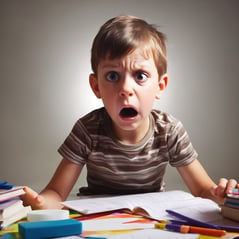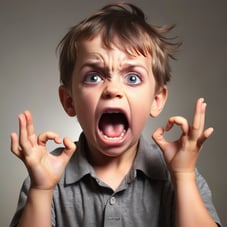CABINET INDIVIDUAL DE PSIHOLOGIE PAP ELENA
servicii psihologice de calitate
ADHD: What It Is and How It Can Be Identified in Children?
ADHD: What It Is and How It Can Be Identified in Children?
2/24/20244 min read


ADHD, also known as Attention Deficit Hyperactivity Disorder, is a neurobiological condition that primarily affects children and adolescents. People with ADHD may experience difficulties in attention, impulsivity, and hyperactivity.
Identifying ADHD in children can be a complex process because symptoms may vary depending on the child's age and developmental level. Generally, ADHD symptoms can be categorized into three main areas:
1. Attention Deficit:
- Difficulty sustaining attention in tasks that require prolonged focus.
- Easily distracted by external stimuli.
- Organization and task completion difficulties.
- Appears not to listen when spoken to directly.
- Frequently forgets things necessary for daily activities.
2. Hyperactivity:
- Constant restlessness and the need to be always on the go.
- Difficulty staying still or keeping their place in situations where it's required.
- Impulsivity in speech or actions.
- Difficulty waiting their turn.
3. Combined Inattention and Hyperactivity:
- Simultaneous presentation of symptoms of both attention deficit and hyperactivity.
To determine if a child has ADHD, it's important to consult with a mental health specialist, such as a psychologist or psychiatrist. These professionals will assess the symptoms and use various tools and tests to make an accurate diagnosis.
Regarding psychological therapy for ADHD, there are several approaches that can help children cope with and manage symptoms. One of the most effective types of therapy is behavioral therapy, which focuses on developing self-control skills and improving communication and social relationship skills.
Another type of therapy that can be beneficial is cognitive-behavioral therapy. This therapy focuses on changing negative thoughts and behaviors and learning stress and emotion management strategies.
Additionally, family therapy can be helpful in treating ADHD as it can improve communication and relationships within the family, as well as understanding and managing ADHD symptoms.
It's important to note that psychological therapy for ADHD is not a magic solution and may require time and patience to achieve significant results. However, progress can be made with the help of a qualified psychologist and through the active involvement of parents and family in the treatment process.
To accurately diagnose ADHD in children, consulting with a psychologist is necessary. Psychological therapy, including behavioral therapy, cognitive-behavioral therapy, and family therapy, can be effective in managing ADHD symptoms and improving the quality of life for children affected by this disorder.
WHAT YOU CAN DO AT HOME?
Therapy for children with ADHD (Attention Deficit Hyperactivity Disorder) can also benefit from the use of products, toys, and gadgets that have been scientifically studied and proven to improve symptom management and support the development of these children. Here are some examples of such resources:
1. Sensory and stimulating toys: Toys that stimulate the senses and provide varied tactile, auditory, and visual experiences can help reduce hyperactivity and impulsivity and improve concentration and attention. Examples include textured cubes, toys that emit relaxing sounds or colored lights, and toys that require active manipulation, such as Rubik's cubes.
2. Construction toys and puzzles: Activities involving construction and assembly, such as LEGO or puzzles, can be helpful in developing concentration, planning, and problem-solving skills in children with ADHD. These toys provide opportunities for creative expression and motor coordination development.
3. Strategy and logic games: Strategy and logic games, such as Chess or Set, can be beneficial in improving cognitive skills and concentration in children with ADHD. These games challenge children to think strategically, anticipate consequences, and solve complex problems, which can contribute to the development of self-control and planning skills.
4. Visual and auditory stimulation devices: Certain devices and gadgets that provide visual or auditory stimulation can be helpful in managing hyperactive and impulsive behaviors in children with ADHD. For example, devices that emit relaxing sounds or regular pulsating lights can help induce a state of relaxation and calm during moments of agitation or restlessness.
5. Time and task management devices: For children with ADHD who have difficulty managing time and tasks, using devices or applications that provide support in organizing and planning activities can be useful. These may include multiple alarm clocks, task management apps, or visual planning charts.
6. Biofeedback devices and virtual reality technology: Some gadgets and technologies have been developed to help children with ADHD improve self-control and attention. For example, biofeedback devices that monitor brain activity or stress levels can be used in a training program to develop self-control and concentration skills. Additionally, virtual reality technology can provide opportunities for training in controlled environments to improve focusing and attention skills.
These are just a few examples of products, toys, and gadgets that have been scientifically studied and proven to be helpful in therapy for children with ADHD. It's important for parents and professionals involved in caring for these children to collaborate to identify the most appropriate resources and strategies for each child's individual needs. Additionally, it's essential to consider the child's preferences and interests to make the therapeutic experience as enjoyable and effective as possible.




